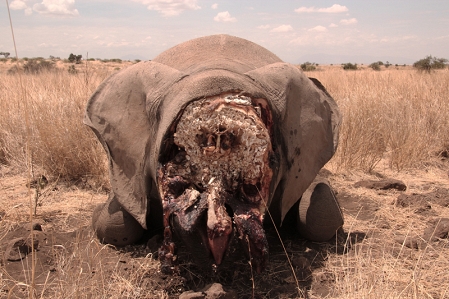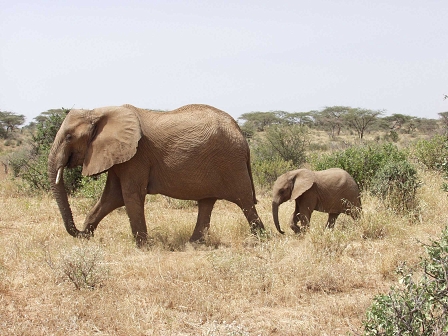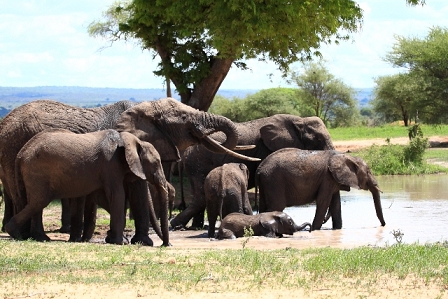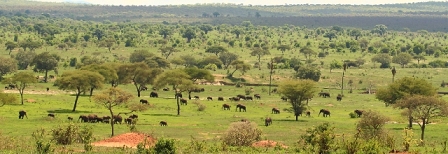Erstellt am: 8. 3. 2013 - 21:10 Uhr
The Ivory Wars
The two elephants lay close together in the scrubland of south-eastern Kenya, surrounded by a trail of blood that had been turned blackish-brown and viscous by the hot savannah sun.
The animals had been shot dead by poachers around 5 days earlier. "It was one of the most horrible sights I've ever witnessed in my years as a foreign correspondent," says British journalist Gabriel Gatehouse, who came across the cadavers when he accompanied a team of Kenyan wildlife rangers on an anti-poacher patrol.

tusk
Because poachers hate to waste a single gram of the valuable ivory, the elephants’ faces had been hacked off to get to the roots of the tusks. Gatehouse describes how maggots were "literally gushing out" of patches of broken skin. "The stench was quite indescribable," he says.
Worse was to come. A path of darkened blood led to the putrefying remains of three more elephants. "They'd clearly tried to huddle together out of some sense of safety because they'd died all of top of each other," describes Gatehouse, who saw the casings of AK-47 bullets near to this macabre pile. Surprisingly few bullets had been used: "The rangers told me that the rangers must have been excellent shots."
This Saturday's Reality Check Special focusses on elephant poaching across Africa, which is said to be at its highest level in 20 years. Driven in large part by demand for ivory from Asia, and in particular from China, armed gangs are slaughtering thousands of elephants from Kenya to Cameroon in order to take their valuable tusks. According to the Born Free Foundation 32,000 elephants were killed on the continent in the last year alone. "We've seen a dramatic rise in poaching of elephants right across the continent," says Charles Mayhew, the founder and director of the conservation charity Tusk Trust, adding that "regional extinction is a real threat."
The issue dominated this week's 178-nation Convention on International Trade in Endangered Species, or CITES, meeting in Bangkok in Thailand, where it was reported that in the past decade, the number of elephants killed has doubled and the amount of ivory seized has tripled.

tusk
Stopping the killing won't be easy. Kenya has, according to Gabriel Gatehouse, "one of the most efficient wildlife protection services in the world" and yet even it is still struggling to stem the slaughter. Elephants roam over massive swathes of land giving poachers plenty of space to operate undetected. When they are outside the confines of the well-patrolled national parks the elephants are even harder to protect. In December a family of 9 elephants was massacred outside the park. It was the worst single incident of slaughter in Kenya in decades.
Charles Mayhew says the charitable donations that Tusk receive are put towards strengthening the defense of the elephants. He says his anti-poaching teams are "putting their lives on the line every day", but, even with the support of GPS tracking and aerial surveillance units, there is a limit to what these rangers can achieve.
"This is becoming a war," says Gabriel Gatehouse, "and one that is becoming increasingly militarized." Both the rangers and the poachers are heavily armed and ready to use their guns. Gatehouse describes many of the groups protecting the elephants as "basically private militias".
Their methods are tough. One group told him, in no uncertain terms, that if they saw poachers their tactic was "to shoot to kill." No effort is made to apprehend the poachers and hand them over to the authorities.
This Wild West philosophy is partly due to the personal danger involved in protecting the elephants and partly due to a frustration with what many people see as a disproportional leniency of the penalties for poaching. Gatehouse says that a convicted poacher might get away with a $500 dollar fine in Kenya. The street value of ivory is often more than $200 per kilo. A single adult tusk typically weighs up to 15kg. You can do the maths yourself.
In a region where poverty is endemic, and guns are plentiful, it is not surprising that the Kenyan poaching gangs find recruits easily: "For many people," says Gatehouse, "poaching is worth the risk."
That's why the charity Tusk wants governments in and outside of Africa to increase the penalties for involvement in poaching. "We need a real deterrent," says Mayhew.
Achim Steiner, the executive director of the United Nations Environment Programme, has described wildlife trafficking as "a business of enormous proportions" comparable only to the trade in arms and drugs. "This is not a small matter," he told delegates in Bangkok, "It is driven by a conglomerate of crime syndicates across borders."

Owen Kilgour
But the problems in East Africa pale into insignificance compared to the situation in the thick jungles of Cameroon, DR Congo, the Central Africa Republic and Gabon. In these remote regions, Mayhew says it is hard for conservationists to get a clear idea of the scale of the problem, but new research suggests that more than 11,000 elephants have been killed since 2004 in Gabon alone. The wildlife authorities there suggest that in recent months they have been slaughtered at a rate of about 50-100 a day.
Samantha Strindberg of the Wildlife Conservation Society (WCS) has warned of the potential extinction of Africa's forest elephants within a decade.
The Real Front Line in the Ivory Wars
Yet in this case even stiff penalties will be of limited use. The arm of the law isn't long enough to reach deep into the forest where the poachers are active, and poverty country combined with the high street value of ivory leaves local officials tasked with fighting the trade vulnerable to corruption. Bas Huijbregts of the WWF complained to the the BBC that "When arrests are made, they are often obstructed by government people who have a stake in the trade as well."
More photography from Owen Kilgour's Images of our World series
Much of the ivory from East and Central Africa finds its way to the ivory markets of Kinshasa and Lagos, from where it is smuggled to the Far East. "In China ivory remains a symbol of status, power and wealth," says Rob Brandford of the David Sheldrick Wildlife Trust. Increased affluence in China in recent years has led to an exploding demand for ivory status symbols.
When Gatehouse visited the Lekki Market in Lagos with a team of undercover journalists he witnessed a burgeoning trade carried out with very little secrecy. A BBC journalist from China was sent in among the stalls and Nigerian traders immediately approached him with the greeting: "Nǐ hǎo, xiang ya?" That is mandarin for "hello, ivory?" He was offered carved pieces such as chopsticks and trinkets but one trader offered to supply him with 100kg of raw tusks.
For many conservationists the answer to the problem lies in stamping out the appetite for ivory. But that would be incredibly difficult, says John Frederick Walker, who has written a book on the trade called Ivory's Ghosts.
"Ivory has been an important organic treasure throughout history, from ancient Egypt, to 19th century Europe, to modern day Japan," he points out. "There has hardly been a world culture that hasn't been attracted to Ivory." It is tactile, says Walker, and allows "exquisite carving." People will continue to desire it.

Owen Kilgour
International trade in ivory has been illegal since 1989, when uncontrolled trade was driving the poaching of an estimated 100,000 African elephants a year for their tusks. But the body regulating the ban, the Convention on International Trade in Endangered Species of Wild Fauna and Flora, or Cites, has twice allowed a one-time sale of African elephant ivory to buyers in Japan in 1997 and then to buyers in China in 2008. That ivory came from stockpiles in countries like Botswana, Namibia, Zimbabwe and South Africa where CITES deemed the elephant populations had sufficiently recovered.
Many conservationists resent these one-off "legitimate" sales, saying they keep the world's population hungry for ivory, whetting appetites for more and making it easier for smugglers to hide their poached ivory among the officially sanctioned sales. "Flooding the market with legal ivory provided a smokescreen for the black market trade," says Rob Brandford.

owen kilgour
John Frederick Walker thinks it would be more effective to "harness the demand for ivory" by allowing "a small but consistent" legitimate trade from ivory gathered from elephants that have died from natural causes in Africa's well-patrolled national parks.
The trade, suggests Walker, would bring well-needed "guilt free" income to poor communities which could be reinvested in conservation schemes. "The ivory left behind by elephants when they die is a possible source of funds that could be used for elephants. Elephant conservation is very expensive."
Walker concedes that this would of course need a hi-tech authentication procedure to make sure the system isn't abused, but he insists that the tools that would make this possible already exist
Conservationists' opposition to this sort of trading is partly due to the rejection of the notion of an elephant as a commodity. Yet Walker points out that the same experts trumpet the financial value of elephants for tourism revenue. Walker argues that our culture has finally reached the important step of recognizing the "intrinsic of worth elephants" beyond their ivory, but that shouldn't stop us being pragmatic.
It is a controversial opinion in an emotional debate. The fact that in Europe, it has been possible to label horse meat as prime beef makes me skeptical of any attempts to separate legal from poached ivory without inviting corruption, but who would want to deny poor people a source of income?
One thing on which all conservationists agree is the need to act swiftly to protect elephants from poachers more effectively before populations are pushed to the brink. To this end new technology is already being harnessed. This year, for example, Kenyan authorities have begun installing an alarm system that alerts rangers to possible poaching crimes by text message. The WWF says it will use part of a $5 million grant it received from Google to launch surveillance drones to protect wildlife in "one African country" this year.
"These criminals must be stopped," CITES Director-General John Scanlon told the meeting in Bangkok, "and we need to prepare to deploy the sorts of techniques that are used to combat the trade in narcotics to do so."

owen kilgour
Austria is far from the frontline of the struggle, but Charlie Mayhew of Tusk says that regardless of where we live we can't afford to take our eyes off the fight to protect these magnificent creatures.
He describes Africa's biodiversity and habitat as "the last great wildlife show on Earth" and concludes that he's "not willing to let our generation be the one that lets this disappear on our watch."


